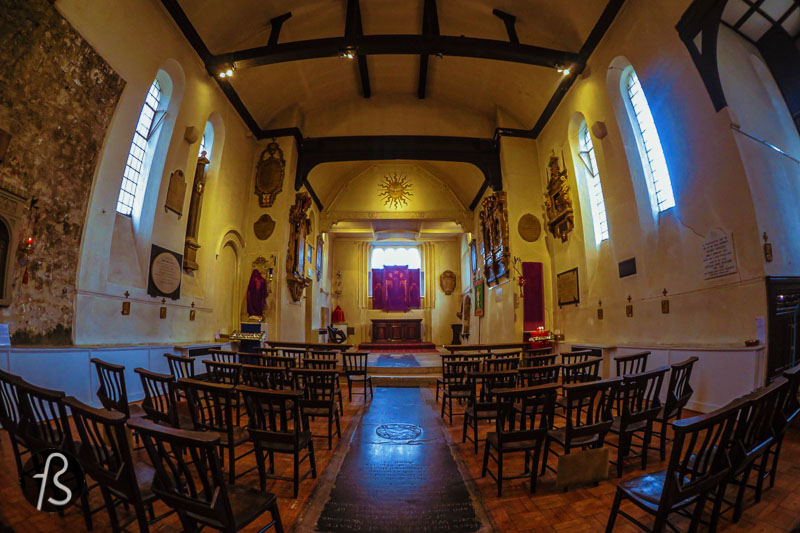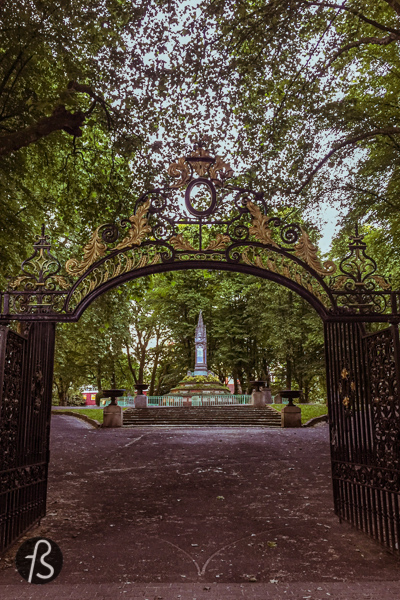The St Pancras Old Church in Central London is the subject of many rumors that point it as one of the oldest sites of Christian worship in England. What caught my attention was the appearance and atmosphere of the countryside church in the heart of London.
Dedicated to the Roman martyr Saint Pancras, The church can be found on Pancras Road, right behind St Pancras International’s train station. This is how I end up visiting it for the first time.
I was going to have beers in Camden when I spotted this small church and felt like something was unusual. I was right since this was one of the most unexpected places in that part of London.
- The history of the St Pancras Old Church
- The Churchyard at St Pancras Old Church
- Mary Wollstonecraft
- Hardy Tree
- St Pancras Old Church Today
A bit of the history behind the St Pancras Old Church in London
As I said before, the church has the appearance and atmosphere of a country church, and this happens because this is precisely what the church is. The church you can visit today is witnessing the growth and change that the surrounding area went through in the last centuries.
In the past, the small hill on which the St Pancras Old Church stands rose above the flooded valley of the Fleet River, which has been covered over for a while now. Some historians suggest that there used to be a Roman camp in the area and the direction of King’s Cross and Euston. Due to that, the hill may have been a site of a shrine that was, later, converted to Christian use. This makes the St Pancras Old Church one of the oldest places of Christian worship in London.
If you want to see some of its histories, you can look for traces of recycled Roman tile on the exposed medieval wall. This could be the legacy of the ancient Roman camp, but we can never be sure about that.
The first documents regarding the St Pancras Old Church appear in the eleventh century. The Domesday Book, a manuscript survey of England and Wales that was completed in 1086 by order of King William the Conqueror, records the connection between the church and St Paul’s. With this information in mind, historians consider the church to pre-date the Norman Conquest of England.
From the thirteenth century on, the church fell increasingly into disrepair. There is a survey from 1297 that states that the church’s roof was in desperate need of repair. During the Reformation years, the St Pancras Old Church escaped action but, during the English Civil War, the building became a lodging for soldiers since it was deserted.
During these years, the St Pancras church was part of a tiny rural community, outside the London city walls. In 1593, a topographer called John Norden described it as a forsaken place surrounded by old and decaying buildings that leave the church as a remote place in the parish. This might be why it was primarily used as a burial ground.
When the St Pancras New Church opened up in 1822, the old church fell into disuse and, by 1840, it was almost in ruins. With the growing industrialization of London, the area around the church was growing more and more. By 1847, the church went through a restoration process. The old tower was removed, and a new one was built on the south side of the church. The whole exterior of the church was refaced, and its capacity increased from 120 to 500 people.
During the Second World War, the church was severely damaged, and, by 1948, it was repaired and restored again. This is the work and style that you can, pretty much, see around the St Pancras Old Church today.
The Churchyard at St Pancras Old Church
When you visit the St Pancras Old Church in London, you’ll need to spend some time exploring the most significant green space in Camden. The churchyard used to a graveyard, but it ceased working like that in 1854 by which time it has accommodated centuries of burials. Not only for parishioners but also from Roman Catholics from all around London. Some records say that, between 1689 and 1854, almost 90,000 burials took place, and are than 30,000 took place in the final 20 years before the graveyard closed down.
You should take a look at the tombs in the graveyard since there is so much history in the location. One of the most interesting ones is Sir John Soane, who was one of England’s most celebrated architects. His tomb was one of the visual inspirations that Sir Giles Gilbert Scott used to develop the red telephone box design that you can see all around the United Kingdom.
Mary Wollstonecraft
Another famous burial in the church is the one from Mary Wollstonecraft, whose remains have since moved to Bournemouth during a time when the railway disrupted the churchyard. She was a writer and an advocate for Women’s Rights. Her daughter, Mary Shelley, is famous for writing Frankenstein.
In the 17th and 18th centuries, many aristocrats, French emigrés, and foreign dignitaries were buried at the St Pancras Old Church graveyard. When some of the graves were disturbed during the construction of the Midland Railway in 1865, the Burdett-Coutts Memorial Sundial was built. The obelisk acts as a memorial to those buried near the church, whose graves were disturbed.
Hardy Tree, a melding image of death and life
Another unusual memorial in the area is the Hardy Tree. It was created by the writer Thomas Hardy in his young days, in the mid-1860s. He was in charge of exhuming the remains and reburying those in the graveyard. After the work was done, there were hundreds of headstones without any function. Thomas Hardy decided to place them in a circular pattern around an ash tree in the churchyard.
Over the years, some of the headstones were absorbed by the tree, creating a melding image of death and life. It’s a grotesque image that has been fascinating writers and artists to this day.
Also, one last thing about the churchyard. The Beatles were photographed in the churchyard ground back in July 1968 for some of the promotional material for the White Album and the single Hey Jude. Today there is a bench plaque that celebrates this moment.
St Pancras Old Church Today
Today, with the growing development of the surrounding area, the church has worked to open its doors to an ever-growing community. You can visit the church every day of the year, and the St Pancras Old Church even became a noted concert venue in North London.
When you visit the place, don’t forget to look for the small booklets they have about the history of the church and the churchyard. Most of the information we wrote here, came from the research we did use what we found in those. Don’t forget to leave a donation to keep this gorgeous and exciting place alive in the heart of London.
A Visit to St Pancras Old Church in Central London
Pancras Road, Camden Town
London, NW1 1UL
posp.co.uk/st-pancras-old-church
If you like what you read here, you should join our Discord channel; there, you will find a place for open discussions about all the themes we talk about here, and it is a free space for you to share your questions, comments and suggestions.
If you are not a fan of the platform, you also can join us on our Facebook group or our Twitter and Instagram. We usually post all the lovely images we see and do there, together with curating the best links of all World Wide Web. No joke!
Subscribe to our newsletter for discounts in hotels and photo gear, freebies and much more.













